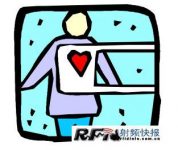
Application of RFID technology in cancer hospitals in Latin America
[ad_1]
Instituto do Cancer do Estado de So Paulo (ICESP) is a 28-story cancer specialist hospital. This hospital is considered to be the largest cancer treatment center in Latin America and is now adopting a Wi-Fi-based real-time location system (RTLS). This makes it easier for employees to respond quickly when the patient is in cardiac arrest. This solution is provided by RFsense and installed by Synergy Tecnologia. It includes Ekahau’s tags and the positioning engine software called Ekahau RTLS Controller (ERC), as well as RFsense’s SIGAME software. The application is customized and the location data Connect with the existing voice-over-IP (VoIP) PBX system of ICESP Hospital.

This real-time positioning system can not only notify employees to respond when a patient’s cardiac arrest, but also track response time, so as to provide hospitals with information to improve their response process. Ekahau’s ERC tracks the location of Wi-Fi-based RFID cards worn by employees, including those in the rooms of patients with heart attacks, while SIGAME software receives the data and integrates with the VoIP PBX system.
ICESP Hospital is newly built, and this real-time positioning system was officially launched in the summer of 2010 when the hospital began to accept patients. This hospital mainly focuses on patients who suffer from cancer and are at risk of cardiac arrest. The hospital has 28 floors and more than 500 beds. There are two situations for cardiac arrest: the blue alarm, which requires a response within three minutes, and the yellow alarm, which requires a response within 5 minutes. Responding quickly is a difficult task, and employees may have to run back and forth between more than 12 elevators and 28 floors.
The hospital hopes to have a solution that can utilize the existing Wi-Fi nodes of the hospital to provide two functions: obtain information and pass it to the employee closest to the patient with a heart attack, and store the information that the employee responds to. Help manage and analyze what can be improved in the system. Mauricio Strasburg, President of Synergy, said: “I used to think of installing emergency call buttons in every room, but this requires wiring. At the same time, this button prevents the hospital from obtaining the location of employees.”
The Ekahau T301BD card label is carried by the employee. When starting to work, the employee first logs in on the computer connected to the back-end software of the hospital. The card is wired to the battery charger and the charger is placed in the slot with the LED light. When an employee enters his or her name, the ICESP hospital software instructs the employee to select the flashing card, and the cards are placed in their own charger slots. Then, the system connects the employee with the ID number of the card.
The employee wears a card with a lanyard around his neck. If an employee sees a patient’s cardiac arrest, they can press one of the two buttons on the label (one button for the blue alarm and one for the yellow alarm). This tag will send an alert and then be received by the Wi-Fi node within the reading range. The hospital’s wireless local area network (LAN) transmits this information to the Ekahau RTLS Controller software, which determines the location and signal strength of the tag based on the Wi-Fi node’s ID number, and then sends the location data to the SIGAME software. The SIGAME software sends these data (including the ID number and location of each card and the room number of the sick patient) to the existing VoIP PBX software in the hospital, calculates which employee wearing the card is closest to the sick patient, and sends the information to Corresponding employees.
The employee closest to the patient received an alert on his Ekahau T301BD card tag, indicating the room where the incident occurred. If the employee receiving the alert cannot respond, they can press a button on the label to explain. The PBX software then receives this prompt and sends out a text message indicating that it will send an “upgrade alert” to the rest of the hospital’s staff. The screen on the card displays text messages indicating the room number and alarm level, blue alarm or yellow alarm.
The data in the alert is stored in the hospital’s database. This data contains the data of the employee’s response, the response time and the employee’s identity. Using the relevant information about the response of employees, the hospital hopes to improve its response process, to see what bottlenecks in the hospital cause delays in response (such as elevators), and which employees need further training, or where in the hospital needs more Response time.
Strasburg said that about 20 employees are currently using these tags, and their response to the system has been positive. It’s just that there was a problem at the beginning. Employees would put the card in their pocket and forget to return the card to the charger slot when changing shifts. Sometimes, the card was washed along with the clothes. Therefore, employees now wear cards with lanyards around their necks.
[ad_2]


